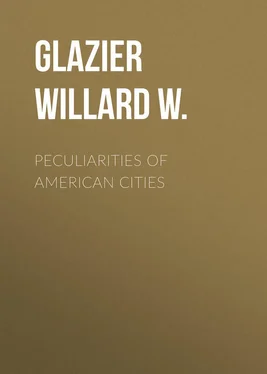Willard Glazier - Peculiarities of American Cities
Здесь есть возможность читать онлайн «Willard Glazier - Peculiarities of American Cities» — ознакомительный отрывок электронной книги совершенно бесплатно, а после прочтения отрывка купить полную версию. В некоторых случаях можно слушать аудио, скачать через торрент в формате fb2 и присутствует краткое содержание. Жанр: foreign_antique, foreign_prose, Путешествия и география, на английском языке. Описание произведения, (предисловие) а так же отзывы посетителей доступны на портале библиотеки ЛибКат.
- Название:Peculiarities of American Cities
- Автор:
- Жанр:
- Год:неизвестен
- ISBN:нет данных
- Рейтинг книги:3 / 5. Голосов: 1
-
Избранное:Добавить в избранное
- Отзывы:
-
Ваша оценка:
- 60
- 1
- 2
- 3
- 4
- 5
Peculiarities of American Cities: краткое содержание, описание и аннотация
Предлагаем к чтению аннотацию, описание, краткое содержание или предисловие (зависит от того, что написал сам автор книги «Peculiarities of American Cities»). Если вы не нашли необходимую информацию о книге — напишите в комментариях, мы постараемся отыскать её.
Peculiarities of American Cities — читать онлайн ознакомительный отрывок
Ниже представлен текст книги, разбитый по страницам. Система сохранения места последней прочитанной страницы, позволяет с удобством читать онлайн бесплатно книгу «Peculiarities of American Cities», без необходимости каждый раз заново искать на чём Вы остановились. Поставьте закладку, и сможете в любой момент перейти на страницу, на которой закончили чтение.
Интервал:
Закладка:
Willard W. Glazier
Peculiarities of American Cities
PREFACE
It has occurred to the author very often that a volume presenting the peculiar features, favorite resorts and distinguishing characteristics, of the leading cities of America, would prove of interest to thousands who could, at best, see them only in imagination, and to others, who, having visited them, would like to compare notes with one who has made their PECULIARITIES a study for many years.
A residence in more than a hundred cities, including nearly all that are introduced in this work, leads me to feel that I shall succeed in my purpose of giving to the public a book, without the necessity of marching in slow and solemn procession before my readers a monumental array of time-honored statistics; on the contrary, it will be my aim, in the following pages, to talk of cities as I have seen and found them in my walks, from day to day, with but slight reference to their origin and past history.
WILLARD GLAZIER.22 22 Jay Street,
Albany, September 24, 1883 .
CHAPTER I.
ALBANY
From Boston to Albany. – Worcester and Pittsfield. – The Empire State and its Capital. – Old Associations. – State Street. – Sketch of Early History. – Killian Van Rensselaer. – Dutch Emigration. – Old Fort Orange. – City Heights. – The Lumber District. – Van Rensselaer Homestead. – The New Capitol. – Military Bureau. – War Relics. – Letter of General Dix. – Ellsworth and Lincoln Memorials. – Geological Rooms. – The Cathedral. – Dudley Observatory. – Street Marketing. – Troy and Cohoes. – Stove Works. – Paper Boats. – Grand Army Rooms. – Down the Hudson.
An exceedingly cold day was February fourth, 1875, the day which marked our journey from Boston to Albany. My inclination to step outside our car and tip my hat to the various familiar places along the route was suddenly checked by a gust of cutting, freezing, zero-stinging air. A ride of between one and two hours brought us to Worcester, a stirring town of about forty thousand inhabitants. Worcester is noted principally for its cotton factories, and as a political center in Eastern Massachusetts.
Springfield, Westfield and Pittsfield follow in succession along the route, in central and Western Massachusetts, the first of which has been made the subject of a special chapter in this book. The last I remember chiefly as the place where, in the summer of 1866, I took my first steps in a new enterprise. Pittsfield has large cotton mills, is a summer resort, and is the nearest point, by rail, to the Shaker community at Lebanon, five miles distant. At Westfield the Mount Holyoke Railroad joins the main line, and semi-annually conveys the daughters of the land to the famous Holyoke Female Seminary .
Leaving Pittsfield we soon reached the State line between New York and Massachusetts. I sometimes think that after a residence in almost every State of the Union, I ought to feel no greater attraction for my native State than any other, yet I cannot repress a sentiment of stronger affection for good, grand old New York than any other in the united sisterhood. The Empire State has indeed a charm for me, and a congenial breeze, I imagine, always awaits me at its boundary.
A ride of another hour brings to view the church spires of Albany, and with them a long line of thrilling memories come rushing, like many waters, to my mind. Here, in 1859, I entered the State Normal School; here I resolved to enter the army; and here the first edition of my first book was published, in the autumn of 1865. The work, therefore, of presenting this chapter upon the peculiar features of the Capital City of New York, may be regarded as one of the most agreeable duties I have to perform in the preparation of these pages.
The traveler now entering Albany from the east crosses the Hudson on a beautiful iron railroad bridge, which, in the steady march of improvements, has succeeded the old-time ferry boat. He is landed at the commodious stone building of the New York Central and Hudson River Railroad, which is conveniently sandwiched between the Delavan House and Stanwix Hall, two large, well known and well conducted hotels.
My first night in a city and a hotel was spent here, at the old Adams House, located at that time on Broadway just opposite the Delavan. I was awakened in the morning by the roll and rattle of vehicles, and the usual din and confusion of a city street. The contrast to my quiet home in the Valley of the St. Lawrence was so marked, I can never forget the impression I then received, and as I walked up State street toward the old Capitol, I almost fancied that such a street might be a fit road to Paradise. Albany was the gate through which I entered the world, and to my boyish vision the view it disclosed was very wide, and the grand possibilities that lay in the dim distance seemed manifold. It is the oldest city, save Jamestown, Va., in the Union, having been settled in the very babyhood of the seventeenth century, somewhere about 1612 or 1614. It was originally, until the year 1661, only a trading post on the frontier, the entire region of country to the westward being unexplored and unknown, except as the "far west." The red warriors of the Mohegans, Senecas, Mohawks and the remaining bands of the "Six Nations" held undisputed possession of the soil, and kindled their council fires and danced their "corn dances" in peace, unmolested as yet by the aggressive pale-faces.
The baptismal name of the embryo city of Albany was Scho-negh-ta-da, an Indian word meaning "over the plains." The name was afterwards transferred to the outlying suburban town now known as Schenectady. An immense tract of land bordering the Hudson for twenty-four miles, and reaching back from the river three times that distance, included Albany within its jurisdiction, and was originally owned by a rich Dutch merchant, one Killian Van Rensselaer, from Amsterdam. The land was purchased from the Indians for the merest trifle, after the usual fashion of white cupidity when dealing with Indian generosity and ignorance. Emigrants were sent over from the old country to people this wide domain, and thus the first white colony was established, which subsequently grew into sufficient importance to become the Capital city of the Empire State.
Before the purchase of Killian Van Rensselaer, a fort was built somewhere on what is now known as Broadway, and was named Fort Orange, in honor of the Prince of Orange, who was at that time patroon of New Netherlands, as New York was at first called. Old Fort Orange afterwards went by various names, among which were Rensselaerwyck, Beaverwyck and Williamstadt. In 1664 the sovereignty of the tract passed into the hands of the English, and was named Albany, in compliment to the Duke of Albany. In 1686 the young city aspired to a city charter, and its first mayor, Peter Schuyler, was then elected. In 1807 it became the Capital of the State. As an item of interest, it may be mentioned that the first vessel which ascended the river as far as Albany was the yacht Half Moon, Captain Hendrick Hudson commanding.
Albany, like ancient Rome, sits upon her many hills, and the views obtained from the city heights are beautiful in the extreme. The Helderbergs and the Catskill ranges loom blue and beautiful towards the south, Troy and the Green Mountains of Vermont can be seen from the north, while beyond the river, Bath-on-the-Hudson and the misty hill tops further away, rim the horizon's distant verge. The city has a large trade in lumber, and that portion of it which is known as the "lumber district" is devoted almost exclusively to this branch. One may walk, of a summer's day, along the smooth and winding road between the river and the canal, for two miles or more, and encounter nothing save the tasteful cottage-like offices, done in Gothic architecture, of the merchant princes in this trade, sandwiched between huge piles of lumber, rising white and high in the sun, and giving out resinous, piney odors.
Читать дальшеИнтервал:
Закладка:
Похожие книги на «Peculiarities of American Cities»
Представляем Вашему вниманию похожие книги на «Peculiarities of American Cities» списком для выбора. Мы отобрали схожую по названию и смыслу литературу в надежде предоставить читателям больше вариантов отыскать новые, интересные, ещё непрочитанные произведения.
Обсуждение, отзывы о книге «Peculiarities of American Cities» и просто собственные мнения читателей. Оставьте ваши комментарии, напишите, что Вы думаете о произведении, его смысле или главных героях. Укажите что конкретно понравилось, а что нет, и почему Вы так считаете.












